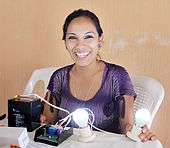The Appropriate Technology Collaborative
| John Barrie | |
|---|---|
 ATC Founder John Barrie
... | |
| Website | http://www.johnbarrie.com |
The Appropriate Technology Collaborative is a U.S. Non-profit dedicated to designing everyday technologies for the global poor.
ATC projects are international collaborative efforts between local grassroots organizations, local engineers and designers, university groups and individuals. Projects are inspired by local needs and interest in developing or improving technologies to make life easier for low-income communities in rural or urban areas.
Some ATC Projects are open to US volunteer participation, where volunteers work as a team with local experts and community members to design and build an appropriate technology in service of Guatemala's low income communities. These projects inspire intercultural collaboration and mutual educational exchange as local and foreign participants share skills and knowledge on the work site. These volunteer trips aid in creating cross-cultural understanding while addressing issues surrounding poverty in the developing world. ATC projects empower local communities to decide what technology is needed, build it, use it and plan for maintenance.
ATC also runs a women's education and business program called “Mayan Power and Light” in which young Mayan women study solar power installation, electrical circuits and carpentry to start their own solar businesses. These solar businesses can market to low-income families who can purchase small-scale systems designed to charge a LED light and a cell phone. Larger systems are also available as families scale-up their solar power systems. The availability of low-cost solar lighting will reduce weekly costs on kerosene, candles or expensive electricity bills. This allows low income families to spend extra cash on nutrition, education or health while increasing their nighttime productivity. Mayan Power and Light aims to grow a new local, green economy that empowers women in business and technical fields.
ATC shares drawings and designs of their appropriate technologies, open-source on their website. These designs have been downloaded in over 40 countries by over 7,000 nonprofits, governments and individuals. Our most prominent projects were implemented in India, Papua New Guinea, Nicaragua, and Guatemala.
The Appropriate Technology Collaborative's Previous Projects Include: Wind Energy, Solar Energy,Solar Vaccine Refrigerator, Solar Replacements for Kerosene Lamps, Squatter City Infrastructure, Water Pumps such as the Treadle Pump and Ram Pump, Hand Crank Water Purifier, Recycled home insulation using corn/rice sacks, Solar Hot Water Heating, Fuel Efficient “Rocket” Stoves, Natural Building with Earth and Lime for ecological and economical home construction
Core Expertise
ATC has extensive experience designing renewable energy systems, potable water, solar refrigeration, ram pumps and low cost biomedical tools.
Gallery
| John Barrie, Small Scale Home Energy System, 2010 |
John Barrie, Girls Carry Water, 2008 |
 John Barrie, Carlos of Xela Teco Working on Solar LED, 2009 |
John Barrie, ATC + MSU Solar Vaccine Refrigerator, 2009 |
 Learning About Solar Power |
Programs
ATC has four primary programs: product design, product development, education and business development.
- Product Design: Choosing what to design is the most important step in creating a successful product for low income people. ATC works with local populations in low income communities to listen, learn, understand needs and communicate possibilities.
- Product Development: ATC creates collaborative design teams that include end users, local engineers, World Challenge Design Teams(tm) and professional mentors. ATC prototypes products at Colleges and Universities, and at the Maker Works facility in Ann Arbor Michigan. Once a new design is proven in the laboratory ATC will prototype the product in the country where it is intended to be used. Local talent is involved throughout the product development process.
- Education:The ATC education program provides opportunities for qualified professional mentors, high school, undergraduate, and graduate students and World Challenge Design Teams. This program promotes a free flow of information between university students and faculty, design clients and ATC's incubated businesses. Most new products developed by ATC, World Challenge Design Teams, or mentors are disseminated online for free from the ATC Website.
- Student design teams who work with ATC are invited to prototype and test the designs in one of the ATC's facilities in Guatemala or Nicaragua. Designs are tested and data is collected in ATC client communities.
- ATC provides an opportunity for student interns, workshop employees and volunteers to participate in the product design and business development process by presenting ATC designs in rural communities, rural clinics, schools, hospitals, and community centers. This outreach demonstrates the affordability, and value of ATC products and increases acceptance in target populations.
- Business Development Starting in 2012 ATC will work with engineering and entrepreneurial talent in developing countries to create new sustainable businesses that provide income to people living in rural villages and urban slums. ATC will teach technical school students in Guatemala how to design and install small scale home energy systems - a proven business model in rural Guatemala.